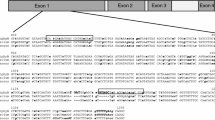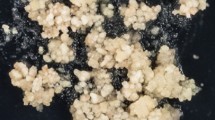Abstract
The plant hormone ethylene is involved in numerous plant processes including in vitro growth and regeneration. Manipulating ethylene in vitro may be useful for increasing plant regeneration from cultured cells. As part of ongoing efforts to improve plant regeneration from barley (Hordeum vulgare L.), we investigated ethylene emanation using our improved system and investigated methods of manipulating ethylene to increase regeneration. In vitro assays of regeneration from six cultivars, involving 10 weeks of callus initiation and proliferation followed by 8 weeks of plant regeneration, showed a correlation between regeneration and ethylene production: ethylene production was highest from ‘Golden Promise’, the best regenerator, and lowest from ‘Morex’ and ‘DH-20’, the poorest regenerators. Increasing ethylene production by addition of 1-aminocyclopropane 1-carboxylic acid (ACC) during weeks 8–10 increased regeneration from Morex. In contrast, adding ACC to Golden Promise cultures during any of the tissue culture steps reduced regeneration, suggesting that Golden Promise may produce more ethylene than needed for maximum regeneration rates. Blocking ethylene action with silver nitrate during weeks 5–10 almost doubled the regeneration from Morex and increased the Golden Promise regeneration 1.5-fold. Silver nitrate treatment of Golden Promise cultures during weeks 8–14 more than doubled the green plant regeneration. These results indicate that differential ethylene production is related to regeneration in the improved barley tissue culture system. Specific manipulations of ethylene were identified that can be used to increase the green plant regeneration from barley cultivars. The timing of ethylene action appears to be critical for maximum regeneration.

Similar content being viewed by others
References
Abeles FB, Morgan PW, Saltveit ME Jr. (1992) Ethylene in plant biology, 2nd edn. Academic, San Diego, CA
Beyer EM (1976) A potent inhibitor of ethylene action in plants. Plant Physiol 58:268–271
Biddington NL (1992) The influence of ethylene in plant tissue culture. Plant Growth Regulation 11:173–187
Bleecker AB, Kende H (2000) Ethylene: a gaseous signal molecule in plants. Annu Rev Cell Dev Biol 16:1–18
Bregitzer P (1992) Plant regeneration and callus type in barley: effects of genotype and culture medium. Crop Sci 32:1108–1112
Bregitzer P, Dahleen LS, Campbell RD (1998) Enhancement of plant regeneration from embryogenic callus of commercial barley cultivars. Plant Cell Rep 17:941–945
Chang Y, Zitzewitz V, Hayes PM, Chen THH (2003) High frequency plant regeneration from immature embryos of an elite barley cultivar. Plant Cell Rep 21:733–738
Cho UH, Kasha KJ (1989) Ethylene production and embryogenesis from anther cultures of barley. Plant Cell Rep 8:415–417
Chow B, McCourt P (2003) Hormone signaling from a developmental context. J Exp Bot 55:247–251
Dahleen LS (1995) Improved plant regeneration from barley callus cultures by increased copper levels. Plant Cell Tiss Org Cult 43:267–269
Dahleen LS (1999) Donor-plant environment effects on regeneration from barley embryo-derived callus. Crop Sci 39:682–685
Dahleen LS, Bregitzer P (2002) An improved media system for high regeneration rates from barley immature embryo derived callus cultures of commercial cultivars. Crop Sci 42:934–938
Evans JM, Batty NP (1994) Ethylene precursors and antagonists increase embryogenesis of barley anther culture. Plant Cell Rep 13:676–678
Fuentes SRL, Calheiros BP, Manetti-Filho J, Vieira GE (2000) The effects of silver nitrate and different carbohydrate sources on somatic embryogenesis in Coffee canephora. Plant Cell Tiss Org Cult 60:5–13
Goldstein CS, Kronstad WE (1986) Tissue culture and plant regeneration from immature embryo explants of barley, Hordeum vulgare. Theor Appl Genet 71:631–636
Kleinhofs A, Kilian A, Saghai Maroof MA, Biyashev RM, Hayes P, Chen FQ, Lapitan N, Fenwick A, Blake TK, Kanazin V, Ananiev E, Dahleen L, Kudrna D, Bollinger J, Knapp SJ, Liu B, Heun M, Franckowiak JD, Hoffman D, Skadsen R, Steffenson BJ (1993) A molecular, isozyme and morphological map of the barley (Hordeum vulgare) genome. Theor Appl Genet 86:705–712
Kotsias D, Roussos PA (2001) An investigation on the effect of different plant growth regulating compounds in in vitro shoot tip and node culture of lemon seedlings. Sci Horticult 89:115–128
Locke JM, Bryce JH, Morris PC (2000) Contrasting effects of ethylene perception and biosynthesis inhibitors on germination and seedling growth of barley. J Exp Bot 51:1843–1849
Murashige T, Skoog F (1962) A revised medium for rapid growth and bioassays with tobacco tissue cultures. Plant Physiol 15:473–497
Purnhauser L, Medgyesy P, Czako M, Dix PH, Marton L (1987) Stimulation of shoot regeneration in Triticum aestivum and Nicotiana plumbaginofolia tissue cultures using the ethylene inhibitor AgNO3. Plant Cell Rep 6:1–4
Reid MS (1995) Ethylene in plant growth, development, and senescence. In: Davis PJ (ed) Plant hormones, 2nd edn. Kluwer, Dordrecht, The Netherlands, pp 486–508
SAS Institute Inc. (1999) SAS/STAT User's Guide, version 7–1. SAS Institute Inc., Cary, North Carolina
Sharma VK, Hansch R, Mendel RR, Schulze J (2005) Seasonal effect on tissue culture responses and plant regeneration frequency from non-bombarded and bombarded immature scutella of barley (Hordeum vulgare) harvested from controlled environment. Plant Cell Tiss Organ Cult 81:19–26
Songstad DD, Duncan DR, Widholm JM (1988) Effect of 1-amino-cyclopropane-1-carboxylic acid, silver nitrate, and norbornadiene on plant regeneration from maize callus cultures. Plant Cell Rep 7:262–265
Suttle JC, Kende H (1978) Ethylene and senescence in petals of tradescantia. Plant Physiol 62:267–271
Turhan H (2004) The effect of silver nitrate on in vitro shoot development in potato. Biotechnology 3:72–74
Vain P, Yean H, Flament P (1989) Enhancement and regeneration of embryogenic type II callus in Zea mays L. by AgNO3. Plant Cell Tiss Org Cult 18:143–151
Author information
Authors and Affiliations
Corresponding author
Additional information
Communicated by K. K. Kamo
Rights and permissions
About this article
Cite this article
Jha, A.K., Dahleen, L.S. & Suttle, J.C. Ethylene influences green plant regeneration from barley callus. Plant Cell Rep 26, 285–290 (2007). https://doi.org/10.1007/s00299-006-0252-0
Received:
Revised:
Accepted:
Published:
Issue Date:
DOI: https://doi.org/10.1007/s00299-006-0252-0




